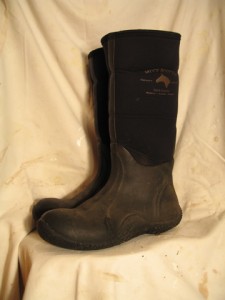Trumbull, CT
February 9, 2010 by admin
Filed under Garden Lectures
Off-season? There’s no such thing! Winter is when I get a chance to do one of my favorite things: meet other gardeners and share with them what I’ve learned through the years gardening for myself and my clients. If you’d like to have me speak to your group about cottage gardening, shade gardening or any other subject, please let me know by clicking on this Contact form. For a list of all the shows I’m currently giving or creating, look here. If you don’t see what you want, just ask—I’m always happy to craft a custom show to accommodate particular interests. Finally, check my Lecture Schedule page for news on upcoming presentations, and thanks to all who invited me to speak in the past!
Next lecture:
A Connecticut Cottage Garden: Adapting a Classic Garden Style to New England
Saturday, March 13; PRE-REGISTRATION REQUIRED
When: 10:30 AM-noon
Where: Fairchild-Nichols branch of the Trumbull library system, 1718 Huntington Turnpike (Rte. 108, about two blocks north of the Merritt Parkway), Trumbull, CT
Phone: (203) 452-5196
Lectures/Classes 2010
January 11, 2010 by admin
Filed under Garden Lectures
Off-season? There’s no such thing! Winter is when I get a chance to do one of my favorite things: meet other gardeners and share with them what I’ve learned through the years gardening for myself and my clients. If you’d like to have me speak to your group about cottage gardening, shade gardening or any other subject, please let me know by clicking on this Contact form. For a list of all the shows I’m currently giving or creating, look here. If you don’t see what you want, just ask—I’m always happy to craft a custom show to accommodate particular interests. Finally, check my Lecture Schedule page for news on upcoming presentations, and thanks to all who invited me to speak in the past!
Next lecture:
A Connecticut Cottage Garden: Adapting a Classic Garden Style to New England
Saturday, February 6
When: 1:00 PM-3:00 PM
Where: Berkshire Botanical Garden, intersection of Rtes. 102 and 183, two miles from the center of Stockbridge, MA
Phone: (413) 298-3926
Fee: Members, $18; non-members, $24
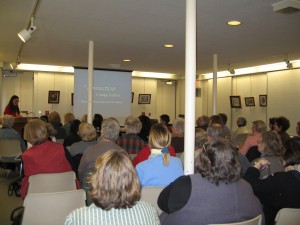
Talking about cottage gardening to a full house at Woodbury Library in March, 2009
Lessons from a Tough Year
January 3, 2010 by admin
Filed under Garden Design, Perennials
2009 was the worst growing season in about a decade. Here in the Northeast, it started out as “the year without a summer” and then became “the year with the summer we wish hadn’t come after all.” After a long, ultra cool and rainy spell it became stiflingly hot and humid practically overnight. Only in September did it become tolerable, but it remained erratic.
While I don’t want to see another year like 2009 any time soon, difficult weather years provide good opportunities to learn valuable gardening lessons. Weather, of course, has a big influence on garden beauty (or ugliness) mostly because of its impact on plant health. When plants struggle, gardens don’t look good. 2009 was a year in which lots of plants struggled.
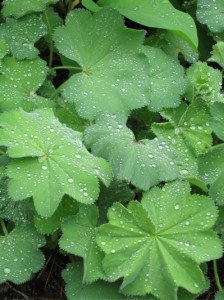
In 2009, lady's mantle withstood weather that devastated many other plants.
Mostly it was a matter of disease. If it was fungal, we had it here in the Northeast: powdery mildew, late blight (along with every other kind of blight), rust, rust and more rust, and rots I couldn’t begin to identify. At one point I heard informally that commercial plant growers were spraying fungicide at unheard-of rates. It wasn’t hard to believe. I, too, sprayed things I’ve never sprayed before in hopes of nipping diseases in the bud, but many normally reliable performers succumbed. The undersides of Hydrangea arborescens leaves became a mass of orange pustules before dropping off prematurely. Snapdragons bloomed half-heartedly and then rotted at the base. Even hostas, normally great performers, were a total loss—not because of disease, but because 2009 was also a record-breaking slug year!
So, what was still looking good at the end of that horrendous season? In the shade department, Hellebore, Epimedium, Siberian bugloss (Brunnera), Geranium macrorrhizum, Rodgersia, white wood aster (Aster divaricata), Heuchera villosa ‘Autumn Bride’, wild ginger (Asarum), ferns and (in light shade) astilbes and lady’s mantle (Alchemilla) were some of the best performers among perennials. That’s what I’d expect. These plants always look good. Any shade garden designed for long-term low maintenance and long-season interest in the Northeast (as long as it’s not a native plant garden) should be made up primarily of plants like these.
Among sun-loving perennials, many North American natives really showed their strength. Bluestar (Amsonia tabernaemontana), turtlehead (Chelone), tickseed (Coreopsis), purple coneflower (Echinacea purpurea), Helenium, Rudbeckia fulgida and Culver’s root (Veronicastrum virginicum) all sailed through summer. Phlox maculata ‘Rosalinde’ proved once again why it’s superior to every other phlox out there.
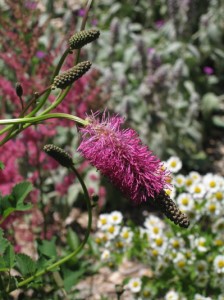
Burnet (Sanguisorba) looks delicate, but it came through 2009 with flying colors.
Among the non-natives, catmints (Nepeta), daylilies (Hemerocallis) and betonies (Stachys) of all kinds seemed no worse for wear, as did some lesser-known perennials such as burnet (Sanguisorba). Grasses showed a lot of resilience, although some didn’t attain their normal size because of the extended cool spring (most ornamental grasses need sun and heat to develop). The story is the same here as for shade plants: the ones that looked good at the end of 2009 were the ones that always look good.
So what’s the lesson here? To fill your garden with plants that are naturally disease resistant. They are the only ones capable of looking good whatever the weather delivers, and 2009 was the proof of that pudding. It’s fine to have some plants you just like a lot, even if you know they’re temperamental, but a garden full of them will eventually disappoint.
This winter, if you’re thinking about making additions to your garden in 2010, my advice is to pay careful attention to the invisible qualities of plants, like disease resistance. They’re the equivalent of a great personality in a human being—they may not be what you notice first, but they’re what you’ll grow to appreciate in the long haul. And with that thought in mind, here’s to some easier gardening years in the coming decade!
Give the Gift of Garden Gear
December is a gift-giving time of year for many people. In light of the upcoming (okay—already upon us!) holiday season, I thought you might find it helpful to know what sorts of tools and implements impress a professional gardener. Gardener gift lists abound, but they aren’t always compiled by people who garden a lot! I garden for a living, and I consider all the items below to be indispensable in my business. They’ve served me well, so I can vouch for their ability to last a long time and give you good value for your money. And if you’ve already finished your holiday shopping, well, file these away as gift ideas for upcoming birthdays and other occasions when you want to give a gardener a gift.
A warning to those of you accustomed to marketing shots of pristine garden products: you’ll find no fancy-pants photos here. These are my actual garden tools in their actual current state, at the end of a long gardening year and before their annual winter cleaning. They’re dirty, and yes, that’s a dropcloth as a backdrop. Use the links provided to see how these products will look “out of the box.”
Full disclosure: I promise that I am neither being paid to recommend any of these products, nor have I received free products, advertising or any other perks to “endorse” them …although I’d like to get all of those!
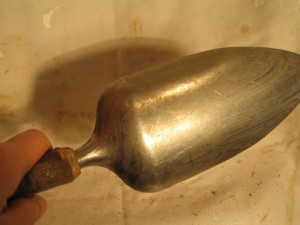
If this Cutco trowel were a person, it would be going on 29…again. It’s dirty, but it’s not rusted or bent.
Cutco trowel
Like so many hand tools, the usual problem with trowels is that they’re not strong enough. At the top of the blade where it thins to mate with the handle, a cheap trowel will bend if you try to dig in less-than-ideal soil. My Cutco has never bent and doesn’t have so much as a hint of rust after seasons of use. That’s never happened before, and I’ll never use any other trowel. As a welcome added feature, it’s also got a comfortable grip. You can see it at Cutco.com. Follow instructions at the website to order directly from the manufacturer. At $42, the price seems high for a trowel, but if that trowel lasts as long as half a dozen other ones (and I think mine will), it seems like a great bargain to me.
Atlas gloves
A glove’s a glove’s a glove, right? Wrong. There are big differences between garden gloves. Nitrile gloves are my favorite because they’re thin enough to allow decent dexterity, yet they provide all the protection your hands should need for ordinary jobs. Atlas nitrile gloves have an extra long cuff that can be tucked inside or over your sleeve ends so you don’t get that “bracelet” of dirt around your wrist after a few hours of work. They come in bright colors that won’t disappear into the vegetation if you take them off for a moment in the garden and absent-mindedly walk away. (I recommend blue, pink and purple for their visibility.) They will not shrink when machine washed and dried, and each pair lasts for months even with constant use. You can view and order these gloves at a great price (2 pair for $6) from Gardener’s Supply, but many hardware stores also stock them, so check your local retailers.
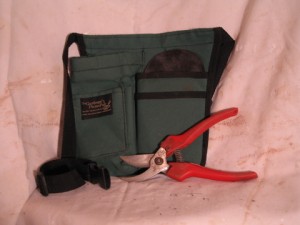
My favorite Felco F300 pruners and Napa Valley Gardener’s Phone Pak, a little worse for wear.
Felco F300 bypass pruners
Felco pruners are legendary…but for many years I couldn’t understand why! Yes, they seemed to be good quality, but none of them fit my hand—they all seemed to be sized for a 6-foot tall lumberjack—so they were tiring to use and expensive to boot. Finally, about two years ago, I found the Felcos for me. The F300 is so lightweight it’s usually referred to as a “snip,” but it’s perfectly adequate for all-purpose light-duty pruning of non-woody material. If you’re deadheading a perennial garden, these are perfect! Aside from being comfortable in my hand, they’re easy to lock and unlock one-handed (a very important pruner feature often overlooked), they slip easily into my favorite pruner holster (see below), and their red handle makes them stand out when I misplace them. Here’s a tip: when the spring broke on my pair (to be expected after a lot of use), I was able to find a suitable and inexpensive replacement in the hardware bins at a local hardware store. You can see and order this pruner for under $20 at Felco’s online store.
The Napa Valley Gardener pruner holster
I wear this pruner holster so much it’s practically a wardrobe staple. (Isn’t that embarrassing?) It’s small and comfortable with an adjustable belt, but it holds a pruner in a plastic-lined pocket, has a phone receptacle large enough to accommodate an “old-fashioned” full-size handset (not just a slimline modern cell phone), and it also has a key clip. Although it has plastic parts, I have machine washed and dried my holster many times, and it has worn very, very well. The full name for this item is actually the Gardener’s Phone Pak. You can view and buy it at Napa Valley Gardener’s website for under $20.
With my Muck boots on, it doesn’t matter how wet the ground is.
Muck Boot boots
Like the pruner holster above, I wear my Muck boots practically every day, and I’ve had them so long I can barely remember buying them. I own the Tack Classic Hi style, which runs about $100 but can probably be found for less with holiday discounts. With these on, you could wade through standing water for hours and your feet would never, ever get wet. They’re great in the garden, but I also use them all winter long while shoveling or blowing snow. There are many Muck Boot styles for different activities, including heavily insulated ones for winter, so look through them all before deciding which one seems right for you. You can also buy replacement insoles—a thoughtful accommodation. You can see all the choices and make a purchase at the Muck Boot website, but I’ve also seen them at Agway stores, and they’re probably available at other farm/feed stores and garden centers.
Protected: War and Peace/Gone with the Wind
October 18, 2009 by admin
Filed under Book Reviews
Let Self-Sowers Do the Work for You
September 24, 2009 by admin
Filed under Cottage Gardening
What is it that gives cottage gardens their special joie de vivre? It’s a question I explore in depth in my new lecture, A Connecticut Cottage Garden: Adapting a Classic Garden Style to the Northeast. (Click here for my lecture schedule.)
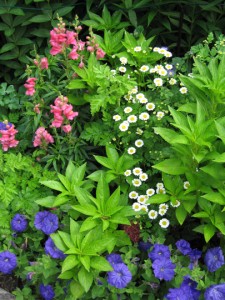
Cottage gardens feature many kinds of delightfully intermingled plants.
The answer to the question actually has many parts. First, cottage gardens are packed with plants. That’s right—they’re just plain crowded, with plants tumbling over one another in a free-for-all attempt to reach the light.
Variety, too, is important. I once estimated that a small cottage garden I made had about 150 different kinds of plants.
So, it’s no wonder that cottage gardens seem to burst with life, or that there’s always something new happening. Put enough plants, and enough different plants, together in one place, and an overflowing, ever changing garden is practically inevitable.
But that’s not quite the whole story. Part of the cottage garden look is a certain accidental-on-purpose feel they have. But how to create that effect?
Funny as it sounds to say, “accidental-on-purpose” is actually not that hard to do. The key is self-sowing plants.
The term “self-sowing plant” is pretty self-explanatory. It’s a plant that spreads more or less readily by seed. It can be annual or biennial or even perennial, although most effective self-sowers fit into the first two categories just because annuals and biennials bloom a short time after germinating, whereas many perennials have to be 2-3 years old before they start flowering.
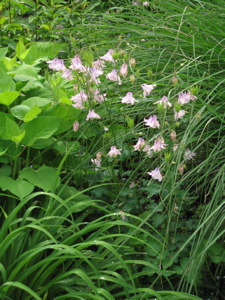
A self-sown columbine looks perfect where it chose to grow.
The magic of self-sowing plants is that they decide where they’ll grow. More than once, I’ve had the experience of finding a self-sown plant in a spot where it looks perfect (although I had nothing to do with it being there), and I’ve wondered, “Why didn’t I think of that?” It’s humbling.
On a more quotidian level, self-sowers are great because they’re huge time and work savers. Think how much effort it would take to start 200 foxglove seedlings in pots and then transplant them all into the garden individually. But by spreading foxglove seed in the garden, I might easily get hundreds of plants the following year with nothing more than a few minutes of time expended.
After the first generation of plants is established, they’ll distribute their seed throughout the garden with no further help from me, eventually giving rise to a stable population of plants that replace themselves as parent plants die out. If they propagate themselves a little too enthusiastically, I always have the option of culling seedlings, but that’s a lot easier than germinating and planting them.
How else do self-sowing plants make a gardener’s life easier? Well, think about the spots that are just too hard to plant manually, such as the joints between flagstones. Self-sowers can fill these tiny nooks and crannies easily—you just have to be patient. And again, when something inappropriate comes up—say, a five-foot plant in the middle of a narrow pathway—you can remove it.
At their best, self-sowers represent the combination of the gardener’s genius and the garden’s genius: the gardener provides the raw material and the garden runs with it, but the gardener always gets the last word.

Forget-me-not is a classic cottage garden self-sower.
Many classic cottage garden plants are self-sowers. Honesty (Lunaria, also called “money plant”), foxglove (Digitalis), columbine (Aquilegia), flowering tobacco (Nicotiana), feverfew (Tanacetum parthenium, which I prefer in the gold-leaved form ‘Aureum’), Johnny jump-ups (Viola tricolor) and forget-me-not (Myosotis sylvatica) are just a few examples.
Late summer and early autumn is the perfect time to spread seed of most self-sowing plants. It makes sense, because if the plants were already growing in your garden, now is when their seed would be maturing. The seeds of annuals may not start growing until next spring, but getting them in the garden now is a good idea because they’ll be perfectly positioned to take advantage of late winter’s abundant moisture to get them off to a good start.
Biennials probably will germinate now and produce a bit of leafy growth before hunkering down for the winter. In fact, this autumn’s growth will count as their “first year,” so they’ll flower next spring or summer even though they’re less than two years old by the calendar. This is why biennials will flower in your garden every year rather than every other year once they’re established; their age is measured in growing seasons, not calendar years.
If you’ve never grown self-sowing plants before, there are a couple of things you’ll have to get used to. Because most good self-sowers are annuals or biennials, they tend to move around a lot. An annual or biennial parent plant dies off after one or two seasons, and its offspring come up where they will. In many gardens, it would be an annoyance if a plant picked up and moved. In a cottage garden, it’s just charming.
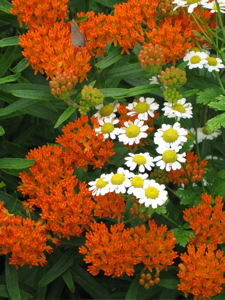
I always put golden feverfew next to butterfly weed if it doesn't seed itself there.
Besides, you can always move a few seedlings if you have your heart set on a plant growing in a particular spot. I do this as needed with golden feverfew, because I always want some growing next to my Ligularia przewalskii, my daylily (Hemerocallis) ‘Bertie Ferris’ and my butterfly weed (Asclepias tuberosa). You’ll discover your own favorite combinations.
Also, you can’t predict just how much of a self-sowing plant you’ll have in any given year. Depending on weather and other conditions, you might have very few specimens of a particular plant one year and a population explosion the next. I’ve learned to accept that sometimes there’s no point trying to figure out why—only the plant knows what motivates it.
Other plants will be consistently abundant. In that case, it’s important to draw a line between unstructured and chaotic in the garden. Be ruthless in removing excess seedlings, or you may regret it later. Morning glory became unmanageable in one of my gardens, and I banished it (although that task took several years). Remember, you’re trying to save yourself work, not create more of it. Deal with problem plants before the situation gets out of hand.
Conversely, a plant you treasure may never self-sow as much as you want in your garden. In that case, just help it along by strewing some additional seed each autumn. I have to do that with foxglove in one garden I keep or it will eventually die out.
There’s one last point I want to make about self-sowing plants, and that’s that they aren’t appropriate in every setting. Non-native self-sowing plants shouldn’t be used where they are likely to escape into the wild. That means keeping them away from uncultivated areas and other people’s property.
I once read an article about a self-sown urban front yard garden. I hope the author’s neighbors had the same taste he did, because it’s 100% certain that they got some of his plants. So be courteous and responsible when deciding to use self-sowers—they can become a nuisance to other people and/or a problem in the environment. I think it’s just a matter of ecological responsibility and neighborliness.
So get a head start on next year by experimenting with a few self-sowing plants in your cottage garden. Below is a list of some good candidates that shouldn’t be too hard to find in seed form. I encourage you to try several to increase your chances of success. Don’t be disappointed if a few don’t work. The essence of the cottage gardening spirit is letting the garden express its personality, too. Love what works, and let what doesn’t go.
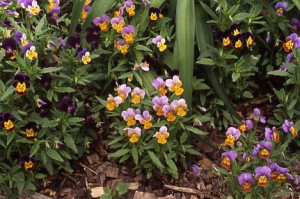
Johnny jump-ups fill in garden nooks and crannies all by themselves.
Columbine (Aquilegia)
Spider flower (Cleome hassleriana)—Potentially invasive, so thin it out if necessary.
Larkspur (Consolida)
Cosmos (Cosmos bipinnatus and C. sulphureus)
California poppy (Eschscholzia californica)—Prefers dry conditions.
Sunflower (Helianthus annuus)
Balsam impatiens (Impatiens balsamina)
Sweet alyssum (Lobularia maritima)
Honesty (Lunaria annua)
Forget-me-not (Myosotis sylvatica)—Potentially invasive, even in wooded areas. Will form a low carpet of flowers in May.
Perilla (Perilla frutescens)—Potentially invasive; deadhead at least some of the crop to keep it under control-you’ll grow this for its purple leaves, anyway.
Poppies (various Papaver)
Johnny jump-up (Viola tricolor)
August Asters
August 21, 2009 by admin
Filed under Perennials, Summer, Summer Bloomers
We’ve all heard the expression “familiarity breeds contempt.” Well, it’s as true in the garden world as in the great wide world. Some of the best garden plants grow wild all around us and never get the recognition they deserve because they’re, well, common.
Native asters are a case in point. The Northeast is aster country, home to handfuls of species, and they’re so widespread that even a short walk down a country lane in August will probably turn up half a dozen kinds.
Never mind that the taxonomists have been at it again and the genus Aster was recently carved up and parceled out into several new genera including Eurybia and Symphyotrichum. “August Symphyotrichums?” I think not. I say if it walks like a duck and talks like a duck, it’s an aster…or, well, you know what I mean.
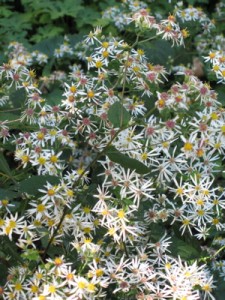
White wood aster is as close to a no-care plant as a plant can get, and native to boot
I have a soft spot for asters, especially the delicate roadside kinds, because they start to bloom at just the time of year when it doesn’t seem like anything should be able to look good. “Sticky heat” is a typical mid August weather forecast in this part of the world, and I know those conditions don’t exactly bring out the best in me. In fact, the word that usually springs to mind when I think of August is “awful!” But when I’m feeling like a wrung-out dishrag, asters are just starting to look cool, fresh and flowery.
Two of the best native species have begun to make headway in the gardening world in the last couple of years and are no longer strictly speaking “specialty plants.” Major plant growers are now propagating them, and you should be able to find them or order them at good nurseries.
My favorite native roadside aster is white wood aster (Aster divaricatus, recently rechristened Eurybia divaricata—yuck!). I frequently say that there’s no such thing as a no-care plant, but if forced at gunpoint to name the closest thing, this would be it.
White wood aster is a well-behaved plant, growing only about 24″ tall and completely capable of supporting itself. Its stems are black and its leaves broad, medium green and attractive. It’s been in the vegetative background for several months now, just growing slowly and steadily, but in the past week its flowers have begun to pop, making it more noticeable.
White wood aster is like a black sweater in your wardrobe-it goes with everything. It’s a little too tall to plant at the very forefront of most gardens, but set back a foot of two in your border it will shine no matter what its companions. White wood aster is sometimes offered under the cultivar name ‘Eastern Star’. To be honest, I can’t see any difference between the species and the supposedly improved cultivar, so don’t fret the presence or absence of a cultivar name.
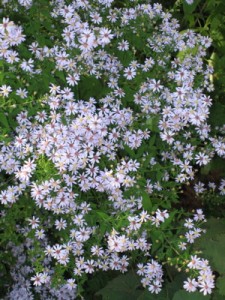
Blue wood aster in all its flowery August glory
The other aster I await with anticipation every year is blue wood aster (Aster cordifolius, recently renamed Symphyotrichum cordifolium—double yuck!). It can grow to four or even five feet in height, and if not staked it will flop over. If grown with enough other tall things around it, it can simply drape itself over them prettily. Possible garden cohorts might include Japanese anemone (Anemone x hybrida), yellow waxbells (Kirengeshoma), toad lily (Tricyrtis), turtlehead (Chelone), snakeroot (Eupatorium rugosum) and northern sea oats (Chasmanthium latifolium).
If you don’t stake it, I’d recommend pinching it early in the season when it reaches a height of two feet or so. You don’t have to get fussy and give it a $100 haircut. One good whack with a pair of hedge clippers, removing up to half the growth, will do the job. “Pinching” it in this way will also delay flowering somewhat, as pinching usually does. You can treat white wood aster the same way if you want it to be shorter or bushier for any reason.
As its name suggests, the flowers of blue wood aster are blue, although personally I’d call their hue more of an icy violet. It’s an interesting color that changes depending on the quality and angle of the light, making the plant something to go out of your way to see at different times of day and in every kind of weather.
Blue wood aster is most frequently offered in a form called ‘Avondale’. It does seem to me that ‘Avondale’ is more floriferous than the straight species, but you can’t go wrong with either one.
White wood aster and blue wood aster share a pair of wonderful traits. First, they aren’t prone to powdery mildew. This common, disfiguring disease afflicts many New England and New York asters, but you’ll see nary a trace of it on the duo I’ve described for you here.
Second, they’ll bloom well even in moderately shady conditions. (Most of the asters traditionally offered in garden centers require full sun to do well.) In fact, I’ve never grown them in anything but some degree of shade, and I’d be curious to get a report on their performance from readers who have used them in full sun. I wouldn’t recommend putting them in deep shade, however. I’m using nature as my guide here-I never see them growing in such a situation in the wild.
So, grant these two lovely native asters the respect they’ve long deserved and give them pride of place in your garden. They’ll give you, too, something to anticipate in “awful” August.
Upcoming Lectures: 2010
August 1, 2009 by admin
Filed under Garden Lectures
As incredible as it seems, the first half of 2009 has already gone into the figurative compost pile. Many more months of gardening remain this year, but gardeners always think in the long term. Not only have I mapped out the changes I’ll be making to several gardens this fall, but I’ve also begun thinking about speaking engagements for the coming winter and early spring. Yes, bookings for 2010 have already begun! If you’d like to have me speak to your group about cottage gardening, shade gardening or a custom topic, please let me know by clicking on this Contact form. Check my Lecture Schedule page for news on upcoming presentations, and thanks to all who invited me to speak in the past!

Talking about cottage gardening to a full house at Woodbury Library in March, 2009
Monarda ‘Scorpion’ and Heliopsis helianthoides
August 1, 2009 by admin
Filed under Eye-Catching Combos
Bee balm (Monarda) is a great perennial for nearly any sunny garden. Modern selections come in a wide variety of strong colors, and most exhibit moderate to strong resistance to the genus’ Achilles heel: the disfiguring disease powdery mildew. Of the purple bee balms, my personal favorite is ‘Scorpion’. Its color is rich and dark without the strong red pigmentation that makes most purple bee balms tend toward the raspberry end of the color spectrum.
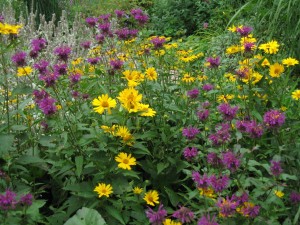
Vivid purple bee balm ‘Scorpion’ and bright yellow oxeye sunflower make a knockout mid-summer combination
A perfect companion for ‘Scorpion’ is oxeye sunflower (Heliopsis helianthoides). This perennial sunflower’s simple daisies are a foil to the mysterious, hooded inflorescences of bee balm, while its sunshine yellow color matches the dark purple of ‘Scorpion’ in intensity. These two plants bloom simultaneously in late July and early August, and both will rebloom to some extent if deadheaded. They require little care as perennials go except well-prepared garden soil and regular watering. Planted together they’ll make a knockout combination in your garden, too!
A Spring Thing: Flowers in the Shade
May 31, 2009 by admin
Filed under Garden Design, Shade Gardening
Here we are at the start of June. By the time summer arrives in three weeks, the majority of perennials in northern shade gardens will already have finished blooming. Is that surprising? You may never have realized it, but most shade tolerant perennials bloom in spring.
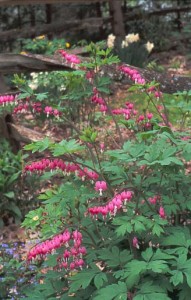
The dangling pink hearts of Dicentra spectabilis are just a memory by the start of summer.
Think about it: hellebore, lungwort, violet, nodding mandarin, epimedium, Solomon’s seal, old-fashioned bleeding heart, most primroses, globeflower, Siberian bugloss, twinleaf, woodland phlox and many other shade standards are already done flowering. False Solomon’s seal, rodgersia, columbine, spotted geranium, bigroot geranium and mayapple are in bloom now, but they’ll be finished by late June, too. Foamflowers are fading (although if deadheaded they’ll put up more flower stalks), and the fruits of baneberry and goldenseal are already fattening up! Yup, flowers in the shade are mainly a spring thing.
What’s left to please the eyes of shade gardeners through the coming months? Goatsbeard, astilbe, hosta, bugbane, Japanese anemone, toad lily and woodland aster are all yet to come. There are more, of course, yet the fact remains that most shade perennials bloom very early in the year. I’d guesstimate 75% of them have wrapped up their flowering by the summer solstice.
There’s a good reason for that, of course. We tend to forget that plants don’t flower to please us. They have their own agenda: reproduction.
In our mostly deciduous temperate forest, the woodland is a full sun environment from November through April when the leaves aren’t on the trees. Most of that time, it’s too cold for perennials to grow, but in March and April, it’s just warm enough for them to shoot up quickly and do energy intensive things like flowering and setting seed while there’s plenty of sunlight to fuel the process. When the trees leaf out in May, many woodland perennials are winding down and looking forward to doing what we all would do if we could get away with it: lounging about all summer.

The best foliage plant ever? Hosta.
The tendency of woodland plants to flower in spring is the main reason why shade gardeners are often advised to stop focusing on flowers and instead rely heavily on exceptional foliage plants: ferns, hostas, sedges, and variegated plants such as (to name just one example) Brunnera macrophylla ‘Variegata’. Flowers will come and go in weeks, but foliage is season long.
Annuals can also help keep color going through the warm months, but the choices for shade in the north are severely limited. Begonias and impatiens are two obvious answers, and they’re readily available at low cost. Gardeners who have grown bored with wax-leaf begonias can try the dragon-wing types for some variety. These grow larger than wax-leaf begonias, are extremely floriferous and make more of an impact, but they also cost more since they aren’t available in 6-packs but have to be purchased in 4-inch pots.
Caladiums are another great choice for summer color in shade gardens, although once again the color is coming from leaves, not flowers. Caladiums are not cold hardy in the North and won’t survive winter in the ground, but they can be dug and stored, dormant, and regrown the following year if you have a bright, warm spot to start them indoors beginning in February or March. Be sure not to put them in the garden too early because they are very sensitive to cool nightime temperatures. Even here in southern New England, I’ve learned not to plant them outdoors until the first week of June. If you do get ahead of yourself with caladiums and they get whacked by an extra-cold night, they should spring back quickly as the weather warms even if their foliage dies back completely in the interim.
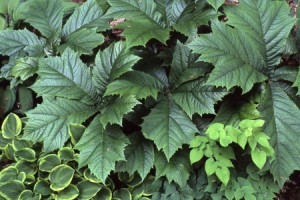
After their flowers have faded, rodgersia and epimedium leaves will continue to bring beauty to the shade garden.
Don’t forget that lots of those spring blooming shade plants I mentioned earlier also have great foliage that will contribute to the beauty of your garden right up until the first frost. Rodgersia, epimedium, hellebore, Solomon’s seal and twinleaf are just a few examples of plants that would be worth growing even if they didn’t flower! So, when designing your shade garden, consider each plant’s total contribution to the effect through the whole growing season, not just the loveliness of its flowers, its most ephemeral aspect.


